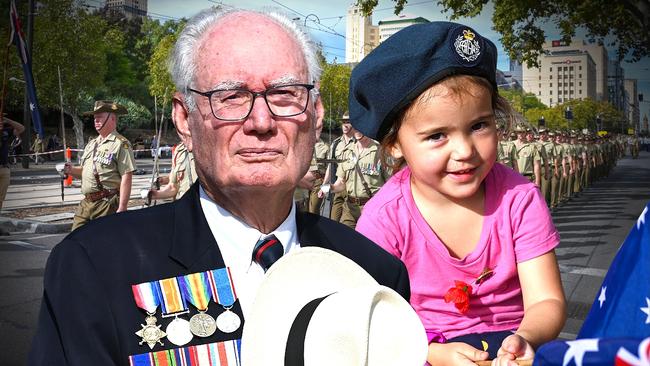Two-up and sausage sizzles after huge crowds flock to dawn services and march
There were massive crowds for Anzac Day services and marches across SA, as the names of six South Australians who died serving their country were added to the War Memorial.
SA News
Don't miss out on the headlines from SA News. Followed categories will be added to My News.
As the sun rose on the most sacred of days on the Australian military calendar, the names of six South Australians who made the ultimate sacrifice were etched into history forever.
Jamie Larcombe, Darren Smith, Scott Smith, Tomas Dale, Andrew Russell and Paul McKay all lost their lives after serving their country in Afghanistan.
And on Anzac Day, as thousands looked on, their sacrifice was honoured with the unveiling of a new plaque on the Post World War II Operations Memorial on North Tce.
The six men were part of 25 new names added to the memorial, unveiled by Governor Frances Adamson and funded by a government grant.
At Tuesday’s Dawn Service, close friends Stacey Dittloff, Adrian Browne and Annette Brown gathered to remember former Kangaroo Island resident Sapper Larcombe, who was shot dead by insurgents in Afghanistan in 2011.
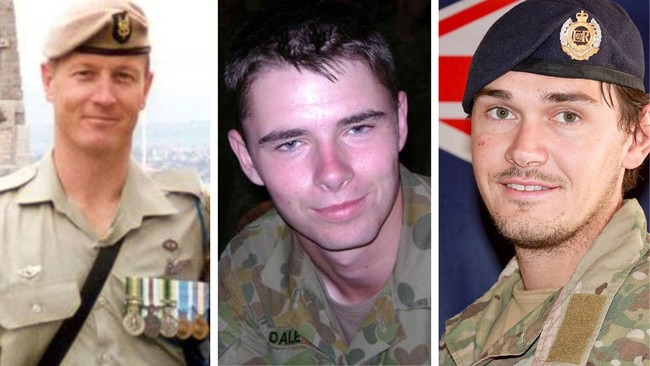

“It’s always hard,” Mr Browne, a former family friend of Sapper Larcombe, said through tears as children Hamish, 6, and Hugh, 4, watched on. Of the six Afghanistan veterans immortalised in the new memorial, Sergeant Russell lost his life first.
Killed in 2002, he was the first Australian casualty in Afghanistan and the first Australian military death since the Vietnam War.
Almost a decade later, Private Dale, 21, was killed in an explosion in 2010 in a horror day for Australian troops which claimed the life of a colleague in the same blast.
Two months earlier, Sapper Darren Smith lost his life after an explosion was detonated by a Taliban insurgent. His explosives detection dog Herbie was also killed in the blast.
Just three years older than Private Dale at the time of his death, Corporal Scott Smith was killed in an explosion in 2012.
After serving in Afghanistan, Captain Paul McKay took his own life in the United States after suffering from post traumatic stress disorder.
About 20km away from the city memorial, at the Semaphore Dawn Service, Squadron Leader and medical officer Benedict Whalley, 41, experienced the day with his young family, including 10-week-old daughter Liliana.
“Certainly from my childhood my parents have always brought me,” he said.
Squadron Leader Whalley, who is based at the Edinburgh RAAF base, was awarded medals for his service in Afghanistan. During the service, he reflected on a “range of sacrifices”. “Over there was some good camaraderie among the Australians and New Zealanders,” he said. “It was nice to be a part of.”
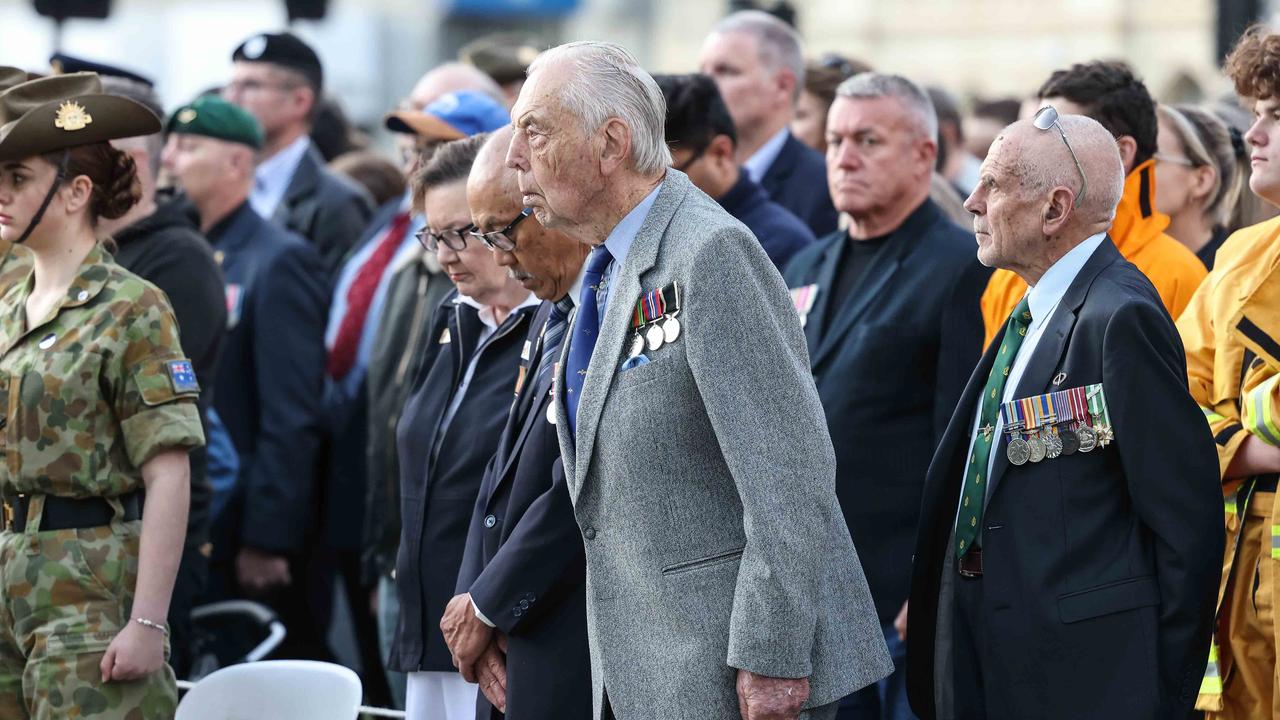
In particular, he remembered his grandfather, Allan Whalley, who was a pilot.
“He served in the Second World War and he was in the Flying Boomerangs,” he said.
Thousands flocked to Dawn Services across the state, with the state’s political leaders and top public servants paying tribute.
Premier Peter Malinauskas, Senator Penny Wong and Police Commissioner Grant Stevens waited patiently to lay wreaths on the memorial at North Tce, for the Dawn Service from 6am.
Mr Malinauskas said he wasn’t surprised to see the big turnout at the second city Dawn Service since the coronavirus pandemic.
“South Australians in particular are becoming conscious of the extraordinary contribution that men and women in uniform make to the safety and security of our nation and the sacrifices that have been made before them as a nation and want to pay homage to it,” he said ahead of the service.
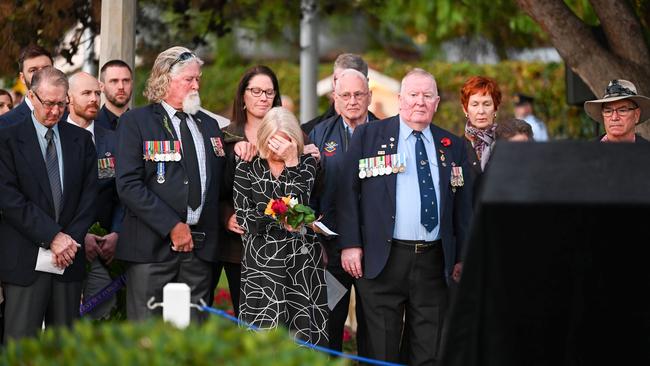
At Semaphore, the service was capped off in high spirits, with a sausage sizzle and RSL members playing two-up on a closed section of Semaphore Rd.
The gunfire breakfast inside the club was packed, with families enjoying meals together.
Kathleen Winger and service member son Daniel Sims reflected on their family members who fought in WWI and WWII.
Military service runs deep in Ms Winger’s family with her Norwegian grandfather Jørgen Christian Jensen, who was later awarded the Victoria Cross, fighting in Gallipoli.
“He became an Australian so he could join up,” Ms Winger said.
The services drew young and old out on a warm Autumn morning, with 101-year-old WWII veteran George Lower proudly taking part in the traditional Anzac Day march.
Mr Lower, who enlisted as a sapper in 1942, served in conflicts in Papua New Guinea and Borneo.
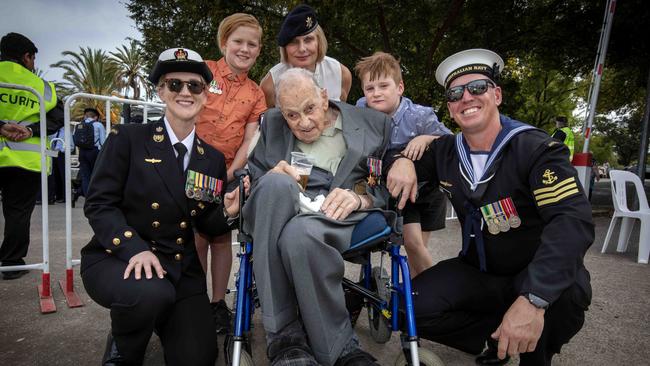
“There were three landings that the Australians did in Borneo,” Mr Lower said. “I did the work that the navy didn’t want to do.”
A knee reconstruction at 40 meant Mr Lower struggled to take part in previous marches but with the help of a wheelchair he was able to march like never before.
Thousands lined the streets to support veterans like Mr Lower and others marching for their loved ones.
Among those matching were father and son Matthew and Thomas Brinkley, who were acknowledging their great-grandfather and grandfather.
“That noise brings back so many memories,” Mr Brinkley said, jingling his grandfather’s medals as he fought back tears. “Just that clanging of the medals.”
Mr Brinkley, who has marched for the past 26 years, has participated with his son every year since he was born.
“It means that I get to be involved in what he got to do,” Thomas, 13, said.
From sombre reflection to two-up and sausage sizzles
Huge crowds have flocked to Anzac Day dawn services in Adelaide and across SA to reflect on the service and sacrifice of generations of South Aussies.
Thousands gathered at the National War Memorial for the city’s service, which is thought to have drawn its biggest crowd since 2015.
SA politicians and top public servants, including Premier Peter Malinauskas, Senator Penny Wong and Police Commissioner Grant Stevens waited patiently to lay wreaths on the memorial at North Tce, for the Dawn Service from 6am.
On a day marked by unusually warm weather and clear skies, thousands also assembled before 6am at Semaphore to remember those who gave their service.
The Semaphore service began with a march of male and female service people as a drum sounded.
President of the Semaphore and Port Adelaide RSL Derek Edwards addressed the crowd and laid a wreath before representatives of various organisations including the navy, army and air force did the same.
Port Adelaide football club, including captain Tom Jonas, and local sporting clubs laid wreaths.
Medical officer from Edinburgh RAAF Base Benedict Whalley brought his family to the Semaphore Dawn Service.
“Certainly from my childhood my parents have always brought me,” Mr Whalley, 41, of Largs Bay said.
The serviceman, who was awarded medals in Afghanistan, brought his 10-week-old daughter Liliana to her first Dawn Service.
He said during the service he was “reflecting on the range of sacrifices”.
In particular, he remembered his grandfather, Allan Whalley, who was a pilot.
“He served in the Second World War and he was in the Flying Boomerangs,” Mr Whalley said.
“Over there was some good camaraderie among the Australians and New Zealanders,” Mr Whalley said.
“It was nice to be a part of.”
His mother, Wendy, who lives in Sydney, was honoured to be able to stand next to her son during the service.
“I’m absolutely bursting with pride,” Ms Whalley, 67, said
During the service she was thinking about “all who served and those who were left behind”.
Local man Barry Hagan, 85, proudly wore the medals he was awarded for national service in the 1950s and honoured the “respect and mateship” of the ANZACs.
“I’ve been coming here for eight or nine years and I matched for 10.”
Russell Patchett, from North Haven, wore his father’s medals.
“I do ANZAC Day to honour him and I reflect on the stories my dad George told me.”
Mr Patchett, 56, who has been attending services for 30 years, said the crowds at the event were “getting bigger each year”.
Long-time member of the RSL, Raymond “piano man” Todd has been playing at the club since 1980.
But the 95-year-old said his involvement goes back further as he has “been playing on ANZAC Day since I was 20”.
Mr Todd remembers his father-in-law, Albert Lukanda, who survived WWI.
“He was shot on the Western Front and my daughter is wearing his medals today.”
Daughter of Raymond Todd, Raelene, 71 also from Largs Bay, marched in the Semaphore service.
“I was marching and I heard someone say ‘c’mon cobba’ and I thought, ‘that’s what my grandfather would say’,” Ms Todd said.
Kathleen Winger and service member son Daniel Sims reflected on their family members who fought in WWI and WWII.
“My father was Norwegian and served in the merchant navy (in WWII) and he did his sailing to serve Australia,” Ms Winger, 73, from Largs Bay said.
Her father, Olav Rye Winger, carried troops and supplies to the Middle East to help the war effort.
Military service runs deep in Ms Winger’s family as her grandfather Jørgen Christian Jensen fought in Gallipoli.
“He became an Australian so he could join up,” she said.

Mr Jensen then fought in Norevil, France in 1917 and Ms Winger described how he used grenades to bluff Germans into surrendering.
He miraculously survived the war but not without scars.
“He was on patrol was he was shot in the head.”
The family visits Mr Jensen’s grave every ANZAC Day.
“After we leave here (Semaphore service) we will go to West Tce where Jensen is buried.”
Mr Sims, 42, of Woodcroft who joined the air force reserves in 2007, described the feeling of camaraderie he gained when engaging in an exercise in Singapore.
“The times I’ve been away with other defence people you get a sense of mateship.”
After the service there was a spirited atmosphere with a sausage sizzle and RSL members playing two-up on a closed section of Semaphore Rd.
The gunfire breakfast inside the club was packed, with families enjoying meals together.
Inside Semaphore RSL, the gunfire breakfast is a tradition that local man known as Chef Steve, 46, organises each year.
“It’s an old digger’s breakfast so I’m honoured to do it,” he said.
It consists of bacon, eggs, tomatoes and baked beans with “a sprig of rosemary on top for remembrance”.
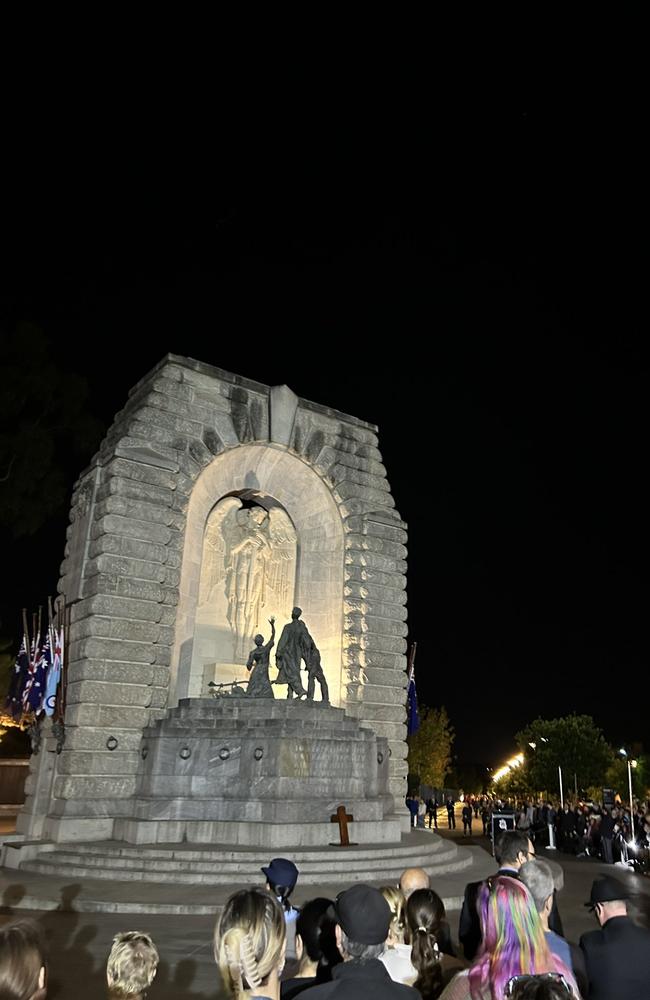
Among those attending the dawn service at the war memorial on North Tce was Henry Young, 99, who served as a fighter pilot in WWII.
Mr Young said he attended the dawn service to commemorate his navy mates, who have all passed away.
“The worst thing when you get old is your close friends leave you,” Mr Young said.
“I hope they’re waiting for me up there.”
Mr Young served in both the British and Australian navies after enlisting in the Royal Navy in New Zealand when war broke out.
“After the war, two of my friends who’d flown with me said we should go across and join up with the Australian fleet,” Mr Young said.
Mr Young spent 13 months as a 20-year-old training as a pilot in the United States before serving in the war.
“You can imagine what that was like as a 20-year-old,” he said.
The 99-year-old, who was born in Adelaide, served on aircraft carrier HMAS Sydney until the Korean War.
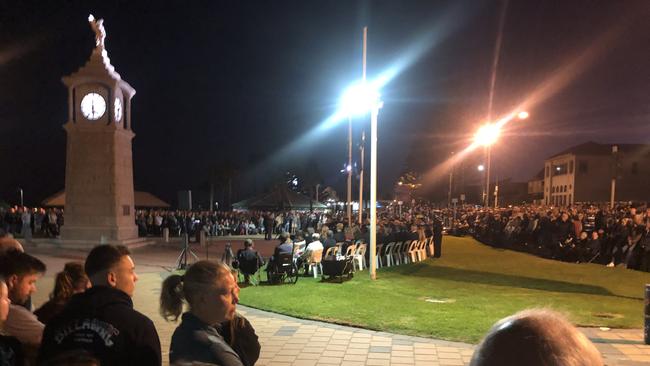
There were reports of unusually large crowds at dawn services across Adelaide and SA.
MFS Chief Officer Michael Morgan said it was a “fantastic” day for South Australia’s firefighters.
“Over our 160-year history, we’ve had so many firefighters that have fought in wars and represented their country so it’s great to be here to recognise their contribution, not only as firefighters to their community, but serving their country,” Mr Morgan said.
Mr Morgan said MFS members would be involved in services throughout the day.
Thousands more lined North Terrace from 9.30am for the traditional Anzac Day March, which made its way from Gawler Place, down North Terrace and onto King William Road.
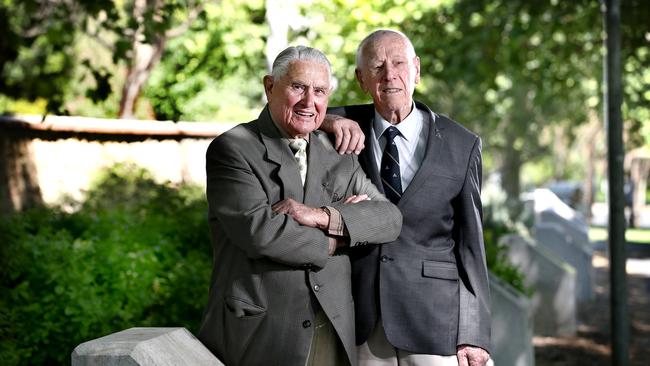
At 9.30am, the first of thousands began marching on North Tce, led by police horses and a marching band.
WWII veteran and former prisoner of war Keith ‘Chook’ Fowler, 102, planned to march with his son, an the son of comrade and friend Jack Thomas.
‘Still hear that chopper’: Vietnam vet’s 15 years of silence
By Todd Lewis
For more than a decade Vietnam veteran and proud South Australian James William – Bill – Hignett wouldn’t talk about his service.
Like many soldiers who returned from the divisive conflict, he refused to acknowledge it.
When he returned home to Australia on January 19, 1972, after 15 months working as a transport driver in the war torn jungles of Vietnam, it was just his parents and his best friend there to meet him.
Unlike those who had served before him, there was no welcome party to recognise his service.
And for the next 15 years, Mr Hignett was angry, agitated and frustrated.
“War is a place to stay away from, there is no doubt at all. It’s an experience that takes all of your emotions,” he said.
A teacher by trade, Mr Hignett had no choice in 1970 when he was conscripted for national service under the ballot scheme.
He lost mates in the conflict. He still visibly shudders at the sounds of war that are so vivid in his memory.
He can still remember the heat of the air when he first landed in Vung Tau, Vietnam, in October, 1970.
“That was the first thing that hit me, It was stifling,” he said.
Most of Mr Hignett’s work involved transporting supplies to bases in Nui Dat and Long Binh as well as taking troops out on operation.
In a soft shell vehicle, on dirt roads in the jungle, his tasks were fuelled with anxiety.
“Prior to us going out on convoy, there were choppers that would clear the area and of course we would always be protected by a gun Jeep in front of us,” he said.
“There was just always this added awareness, the anxiety of being out there, you were just never quite sure what was going to happen.”
He said Christmas Day, 1970 was the day that stuck most vividly in his memory.
“I can’t say too much about it, but we lost two men in our CORE that day – Christmas Day,” he said holding back tears.
“At times I can still hear that chopper coming in.”
He said he lost other friends who died in combat.
“There was one who was a schoolteacher down the road from me who was killed over there,” he said.
“Those memories, they’re still there.”
But despite all that terror that he still endures, upon return it felt like he and other soldiers were targeted for their involvement.
“I think there was a lot of confusion in the Australian community at the time. They couldn’t separate out the politics of Australia’s involvement in Vietnam and unfortunately the soldiers became a target instead of the issues at the time.”
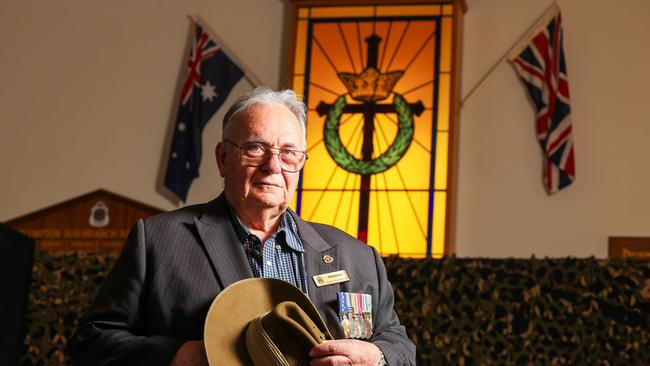
It wasn’t until 22,000 Vietnam soldiers marched through the streets of Sydney in the ‘Welcome Home Parade’ in 1987 that Mr Hignett finally felt a sense of recognition.
He said it allowed him to reconnect with his mates who he served alongside and start embracing a significant chapter in his life.
“That parade helped because I suppose you got to see that there were a lot of others who had similar struggle to what I had,” he said.
“We’ve come a long way since then in Australia and I know a lot of Vietnam veterans, including myself, ensure that those troops who go away now get the proper recognition when they return.”
Now, 36 years later as president of the Plympton Glenelg Returned and Services League (RSL) sub-branch, Mr Hignett has been recognised with an RSL Anzac of the Year award for his service to the community.
He has been heavily involved in getting recognition for Aboriginal veterans. He has managed the Veterans Centre at the Repat health precinct where he has assisted veterans who are struggling.
Mr Hignett he doesn’t do those things for the recognition, but this recent award filled him with pride.
“I was shocked, but I’m extremely proud. You do those things because you feel like it is a part of your obligation of service,” he said.
He said people should use Anzac Day as a day for reflection.
“When people have undertaken military service for the country, whether they go overseas, or they don’t, it’s a unique experience and it’s important for the country,” he said.
“People should ensure veterans are given the proper respect they’re entitled to.”
Anzac tribute to Australia’s worst maritime disaster
By Paul Starick
Australia will be represented on Anzac Day in the Philippines by Trade Minister Don Farrell, just days after the wreckage from Australia’s worst maritime disaster was found off the Southeast Asian nation’s coast.
Senator Farrell, who in March spearheaded a commemoration of the two nations’ famed military ties at an isolated South Australian railway station, will deliver an address at Manila’s most prominent Dawn Service.
The Trade and Tourism Minister will pay tribute to the 4000 Australians who fought during the Philippines’ World War II liberation, including 92 who died.
In speaking notes supplied to The Advertiser, Senator Farrell emphasises last Friday’s “remarkable discovery” of the Montevideo Maru, 81 years after the Japanese transport ship was torpedoed by a United States submarine off the Philippines coast.
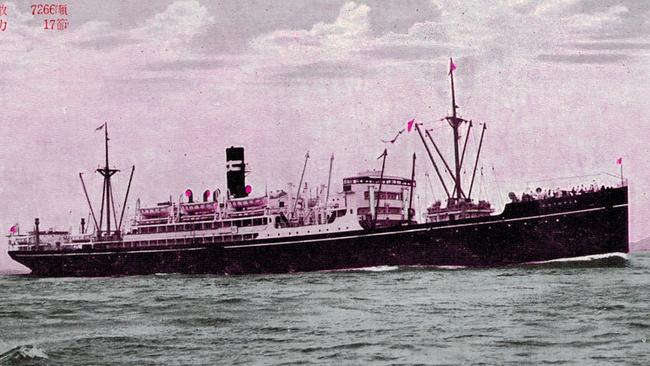
In Australia’s worst maritime disaster, 979 Australian soldiers and civilians died when the ship was sunk on July 1, 1942.
Thanking the Philippines government for support, Senator Farrell will emphasise the “closure the families of the more than 1060 prisoners of war, from 16 countries … now have”.
“In honouring those who have served, (we) reiterate that we gather not to celebrate or glorify war but to honour those who have sacrificed so much in the cause of peace, from the Gallipoli landing to the present,” Senator Farrell’s notes say.
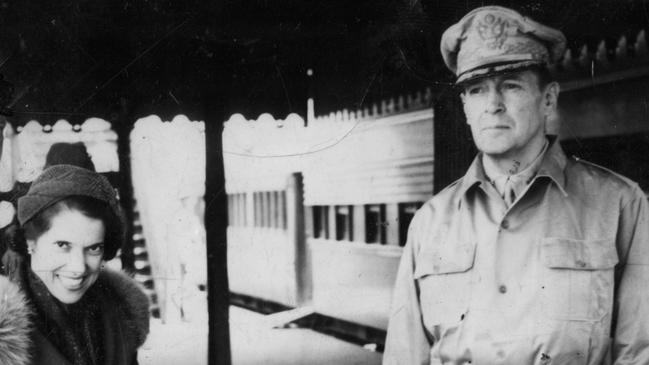
On a trade mission that also included Vietnam, Senator Farrell also will mark the 50th anniversary of the declaration ending Australia’s involvement in the Vietnam War, during which 521 Australians were killed and more than 3000 injured.
Senator Farrell organised last month’s commemoration at Terowie railway station of famed US General Douglas MacArthur making world history on March 20, 1942, by first uttering his catchphrase: “I came out of Bataan (in the Philippines) and I shall return.”
Senator Farrell, whose wife Nimfa emigrated from the Philippines in 1983 and whose uncle flew Catalinas with the RAAF there, will emphasise his strong personal connection to the nation.
The Manila Dawn Service will be held before about 200 people at Libingan ng mga Bayani, where former Presidents, national heroes and service personnel are buried – the Philippine equivalent to the US’s Arlington National Cemetery.

